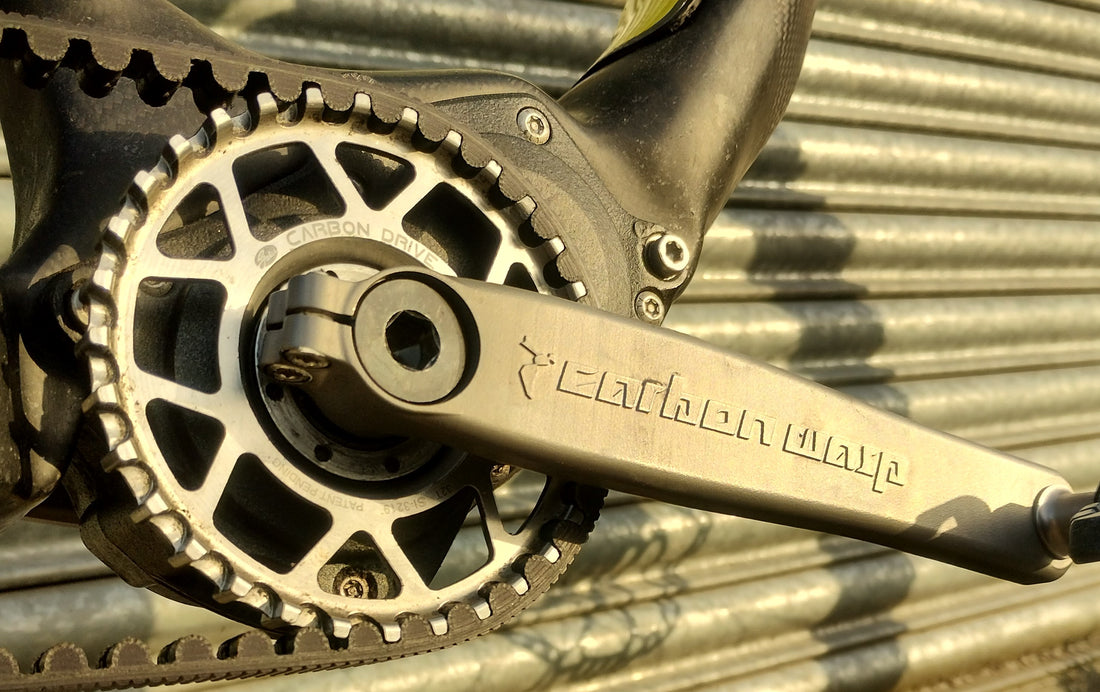Titanium?! A bit off brand isn’t it?
We’ve just released our new 3D printed titanium cranks for the Pinion gearbox – you can have a closer look here and even buy some – but, given it’s our first product that’s not made from carbon fibre, we thought it might be useful to tell you a bit more about how the project came about, why we’re making things from metal and what the future might hold…
We love the Pinion gearbox here at Carbon Wasp – it gives you a huge range of gears in a maintenance-free package that will run and run. Whilst we don’t see anyone racing XC on one anytime soon, it’s perfect for a winter hardtail or long travel enduro/DH bikes. Those use-cases make the most of the benefits of the system and mitigate the drawbacks. We’ve been making and riding hardtail frames with Pinion gearboxes for years and we’ve been making carbon fibre cranks to fit them for nearly as long. The two main drawbacks of the gearbox system for us have always been the shifter – with a grip shift previously the only option – and the overall system weight – whilst the weight is central and low down on the bike, you’ve still got to carry it around. Pinion have solved the first problem, with their wireless trigger shifter, and we can help with the second, by making aftermarket parts to save some weight, starting with cranks.
We originally had a target weight of 300g for a pair of cranks (these are just crank arms, the axle is part of the gearbox), which would save over 150g on the original aluminium cranks. We came up with all sorts of creative ways to clamp the cranks on to the gearbox axle without pinching the carbon fibre but always needed to include some metal inserts – firstly for the pedal threads (which can’t be cut in the carbon with any reliability) and secondly to fit the Pinion axle spline pattern with the aforementioned elaborate clamping mechanism. We never had any problem with the strength of the aluminium inserts or the strength of the carbon fibre, but had no end of issues with bonding the insets to the carbon. This is a common problem with carbon cranks and usually requires fitting the insert as part of the carbon lay up to some extent.
A while back we thought about increasing the size of the metal inserts, so they had more of a surface to grip the carbon and more leverage. Eventually we thought about making the metal inserts so large that they joined in the middle and did away with the carbon altogether. We started to look at making lightweight metal cranks and fairly quickly got in to 3D printed titanium. We’ve long been interested in 3D Printing, we started off years ago using printed moulds for custom parts and have used printing as part of our process ever since, for prototyping and development as well as making tools and fixtures. Metal 3D printing has become far more accessible in recent years and will continue to do so and now seems to be a good time to start to use it as a process for certain end parts.
After doing some sums and then prototyping, we realised we could make hollow titanium cranks as light as anything we could do in carbon, without the problems of fitting inserts. Metal cranks had the added benefit of being more robust than carbon fibre, in an area that is very exposed to impacts. We were certain that 3D printing titanium was the best way for us to make the Pinion cranks. At this point we did consider whether we should be producing metal parts at all, given it was somewhat ‘off brand’. That didn’t last long – we’re pragmatists and we use the best material for the job at hand. For mountain bike cranks, for us, at the moment, that’s titanium. We still think carbon fibre is the best material for many other uses, including frames, but we are always looking at our options. We’re not going to stop making carbon fibre parts, but we are already working on other titanium parts – so watch this space. And no, we won’t be changing the company name, not for the time being anyway.

